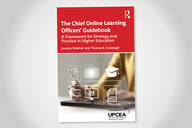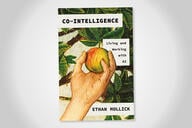You have /5 articles left.
Sign up for a free account or log in.
I first got to know Anne Keehn over a decade ago through her role as entrepreneur in residence and senior fellow at the Gates Foundation. Since her time at Gates, Anne and I have collaborated on numerous projects and convenings. As Anne prepares for her next adventure at the intersections of higher education and technology, she agreed to collaborate on this Q&A.
Q: Anne, you’ve been in higher ed–focused technology and thought leadership roles for the past three decades. Can you give us a brief tour of your career highlights, helping us to understand the professional journey that brought you to where you are now?
A: To quote Socrates, “An unexamined life is a life not worth living.” True confessions, I was an English major. Seriously, thank you for this opportunity to examine my amazing professional journey, which has sometimes unfolded in very serendipitous ways. I am where I am now because of my curious nature and a lifelong passion for learning coupled with my interests in leadership, emerging technologies and improving education experiences—all have influenced so many of my career moves. What’s been most remarkable and memorable for me about this journey are all the wonderful people and organizations I have had the privilege to work with at the intersection of education and technology over the last four decades.
My foray into higher education began the summer after college in a leadership program at Towson University called Project Marj. We led an Outward Bound–based program (rock climbing, rappelling, backpacking) to help transfer and freshman students develop confidence and a better transition to college life. This experience piqued my interest in innovative approaches to learning—and working with colleges and universities.
I moved out West, attended graduate school and eventually took a job at Prescott College in Arizona as a director of development and alumni programs. I met some really interesting people, like Sandra Day O’Connor (which I will come back to later), the Rockefeller family and Janis Joplin’s parents. Her sister was a professor. I was attracted to Prescott College because their motto was “Education is a journey; not a destination.” After a couple of great years, I followed my passion and moved back East to work for a global company, Cable & Wireless. This was during the AT&T divestiture period and a time of transformation for the telecom industry. There, I developed an affinity for emerging technologies and market transformations.
In the late ’80s, as the market for software and computers grew, I joined Datatel, a company that was building what we now call administrative, or ERP, software for higher education. This was an opportunity to combine my interest in technology and education. At Datatel and SCT (now Ellucian), as well as PeopleSoft (now Oracle), I had the opportunity to work closely with just about every office on campus. Sometimes our demos were five days long! Imagine that—you really get to know the inner workings of institutions and meet a lot of people who share a passion for education.
During this time, I held a variety of leadership roles in sales and marketing, then, later in my career, roles in new product development, innovation, M&A, channels and business development. While at PeopleSoft, I had to take FMLA (family/medical leave) to help care for my father, who had cancer. After he sadly passed, I got a phone call from a new CEO, Lou Pugliese, and I made another leap—to the fusion of the internet and education. I had the opportunity to be on the ground floor of a new company founded by Michael Chasen and Matthew Pittinsky, Blackboard. As an early-stage executive, I learned how to rapidly scale a company (read: 1,200 institutions in 101 countries in about 18 months!). There was no playbook for subscription-based licensing at the time. Salesforce was just getting started, and the dot-com era was in full bloom.
Unfortunately, I was faced with personal challenges again. This is life. My mother fell seriously ill, prompting me to lean out again. That’s when I started my consulting practice, Quantum Thinking. I wanted the flexibility to support my mom, spend more time with my sons and keep engaged in my career.
After a couple of years of consulting, Pearson tapped me on the shoulder. They had just acquired eCollege and wanted me to take the company global, in addition to managing their U.S. learning solutions division for higher education. This role marked a shift from ERP and LMS to digital content, deepening my experience in academic affairs and teaching and learning.
At this time, I was also delving into the world of innovation and design thinking, which led to a unique request by Paula Wallace, the president of Savannah College of Art & Design, during a parents’ weekend event. Based on my experience in building great teams, she asked me to co-create a new graduate program with their deans. The design objective was, how do you get creatives to have more business skills and how do you get business people to think more creatively? So we developed an M.A. and M.F.A. in design management. It was a fabulous experience. Ask me about the haunted house they put me up in another time!
Next, I was asked by the deputy director of higher education, Mark Milliron, to organize a team of thought leaders (Lev Gonick, Richard Katz, Celeste Schwarz, etc.) and to lead a research project for the Bill & Melinda Gates Foundation Postsecondary team—“Environmental Scan of Third Party High-Quality Digital Courseware in the US Postsecondary Market.” We now refer to these market providers as OPMs. I then served as president of Kaplan Global Solutions, where several companies reported to me, including an early OPM, Colloquy, and an international student recruitment firm.
Then the unthinkable happened, once again. I needed to lean out to care for my grieving family and husband, who was diagnosed with cancer. Very sadly, it was one year from diagnosis to death. I will never forget the compassion that Andy Rosen, CEO of Kaplan, showed, as well as colleagues and friends from around the world. Sometimes we need to lean out as well as lean in (Sheryl Sandberg), and more importantly, I believe we need to lean together to overcome life’s challenges.
Not too long after, I was asked by Josh Jarrett, the new deputy director, to join the Bill & Melinda Gates Foundation full-time, first as an entrepreneur in residence and then as a senior fellow for technology and innovation. This was an amazing opportunity to work across higher education institutions and ed-tech companies as well as conduct research, convene and weigh in on policy and grant-making. The programs and grants I am most proud of contributing to are: IPASS (Integrating Planning & Advising for Student Success), now called Every Learner Everywhere; Digital Courseware Competition; and one I led, the 2014 Leading Academic Change Project (LAC) and grant.
This work included launching the 2014 inaugural LAC summit and the 2015 Survey of Centers for Teaching & Learning with MJ Bishop, executive director of the University System of Maryland Kirwan Center for Academic Innovation. As you mentioned, it was at the LAC summit when we first met. You have written about this frequently; we were seeing a new field of nonfaculty leadership roles emerging—innovation leaders making significant contributions to the support of faculty and students on campus and online, managing new innovation programs and adopting new learning technologies. The landscape of higher education was changing and new models of support in a digital age were forming.
After my BMGF fellowship, I returned to my global advisory practice, Quantum Thinking, where I continued to work with higher education leaders, foundations, ed-tech companies and venture capital firms. When called upon, I leaned in and took on full-time corporate leadership roles. In 2019, I joined ASU and private equity firm TPG in launching a new work-to-learn benefit company, InStride, based in Los Angeles.
Then, in 2020, during the early days of the COVID-19 pandemic, I was asked to join Zoom to be their global education lead. My experience at Zoom was truly remarkable, engaging globally with educators and education leadership across higher education, K-12 and corporate learning during an unprecedented time. It was an absolutely phenomenal experience seeing online learning go from the [fringes] to the core of learning—a global mass adoption overnight. My initial challenge was launching Zoom’s first virtual event at scale—Zoom Summer Academy—in just five weeks. Our objective was to show educators how to more effectively use Zoom to teach. We reached approximately 92,000 teachers from 105 countries over a two-day period.
All these experiences, leaning in and leaning out, have brought me to where I am now—infinitely passionate about education, emerging technologies and new horizons. Quantum Thinking is focused on the future of learning—innovation leadership, ed tech, research and learning transformation. I continue to scout out new technologies and connect people and ideas. What I am most excited about now is my new research and collaboration project, Leading Academic Change National Survey 2.0.
I also currently serve as an industry adviser to Class Technologies, CampusESP and sit on the advisory board for the University System of Maryland Kirwan Center for Academic Innovation. It has been a very nontraditional professional journey of learning, meeting lifelong friends and colleagues, and, together, making a difference and improving the educational experience for all learners.
Q: What are the professional priorities, goals and activities that you will be focusing on for the next stage of your career?
A: The future of learning is where I am focused today. Based on the Leading Academic Change project and research I led at the Gates Foundation in 2014–15 and having a front-row seat at Zoom, I’m particularly interested in understanding how academic innovation is structured and supported in higher education institutions across the nation, especially post-pandemic. As you have observed and written about with co-author Eddie Maloney, we are seeing new units and leadership models emerge to further institutional transformation in support of faculty and student success and fresh data is needed.
After conducting a feasibility study, it became apparent to me and others that a new survey on leading academic change was needed to help advance the academic innovation and institutional transformation agenda. Spearheading this survey—Leading Academic Change National Survey 2.0—has been my biggest priority over the last 18 months.
Last fall, Quantum Thinking partnered with the University of Michigan Center for Academic Innovation to conduct this research. Cait Hayward, director of research and analytics, is co–principal investigator with me. James DeVaney, associate vice provost for academic innovation, served on the LAC 2.0 survey steering committee. As you know, we formed a national design and steering committee to help shape the survey. Thank you, Josh, for your participation on the design committee and your great insights. We are currently seeking more LAC 2.0 sponsors and grants to help disseminate this important work broadly and to further the learning across institutions.
Our aim for the survey is to advance academic innovation by collecting the data needed to help institutions create a data-informed leadership framework. The results can be used to inform the development of leadership models, resilient support structures and innovative approaches to improve student success.
Broad participation is vital to this effort and will help illuminate the complexity and reach of this work across the institution. Leading academic change is often diffused across the institution and is not often understood internally or by companies trying to partner with them. Our goal is for leaders to be able to be confident in major decisions and ensure they have the resources needed to build and sustain innovative initiatives, including, agency, budget, talent and technology. This knowledge will strengthen organizational leadership capacity and execution—a vital foundation of faculty and student success.
We will be presenting the survey findings through reports, webinars, workshops and conferences like the 100 Year EdTech Project’s 2024 Design Summit, OLC INNOVATE and POD Network. In April, James DeVaney and I will be moderating a panel of academic innovation leaders at the ASU+GSV Summit.
As for my other professional goals, I’m currently exploring Ph.D. programs and plan to continue serving my clients, collaborating and enjoying being a digital nomad in the U.S. and Europe.
Q: What advice do you have for anyone thinking about crafting a career at the intersections of ed tech, publishing, foundations, consulting and universities?
A: When crafting your career, don’t hesitate to explore new opportunities and swim outside established lanes. At the end of the day, you are ultimately responsible for your career path or career mosaic, as I prefer. Honestly, I think it is much easier to change course today than it was even a decade ago. Ultimately, you have to be willing to embrace change and not get stuck in stereotypes. Don’t worry about whether you work for an institution (faculty or administration), then work for a corporation, or take your wisdom and industry knowledge and help a foundation or association shape its vision and strategy. It’s your journey. Be aspirational and make sure your personal goals and professional goals align. If a new role doesn’t work out or you are at a point of diminishing returns, change course and move forward.
I also advise people to get involved—and keep learning! Read industry research, news sources, books and attend conferences. Not only attend, but volunteer to present at industry conferences. I started going to a variety of conferences early in my career, such as ACE, AASCU, AACC and Educause (back when they were Educom and Cause). It’s so important to get involved in the field or industry that you are in—and reach out to others outside and within your organization to grow and learn, broaden your industry knowledge and further your professional skills. Seek out and connect with industry thought leaders; it’s a very rewarding way to collaborate and contribute.
Now, I’d like to follow up with my story from meeting Justice Sandra Day O’Connor early in my career, because it had such a profound impact on me and my decision-making. In 1981, before she was appointed to the Supreme Court, Sandra gave a talk to a group of women in downtown Phoenix. She told us that she took five years off from her law career to be home with her children when they were young. As you can imagine, this was a big unknown fact and unheard-of in those days, especially for those who were afraid of being labeled on the “mommy track” and being held back from promotions.
We asked her how she was able to take the time off (lean out) and not have it hurt her career. She shared these three pieces of advice: stay connected to your colleagues, keep up with your industry knowledge and volunteer in your community to sharpen or learn new skills. I have shared this advice with so many people over the years. Leaning out truly did not hurt her career.
I’ll end with what has been another source of inspiration for me—a quote from one of my favorite poems, “Ulysses,” by Alfred, Lord Tennyson: “To sail beyond the brightest star, to strive, to seek, to find, and not to yield.”




